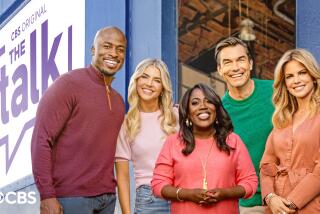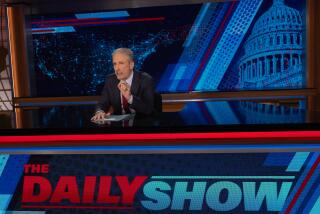Arsenio Hall is asking for a slice of late night

Decked out in a blue blazer and stylish white hat, he bounded onto the ballroom stage at the Beverly Hilton as if he could barely contain himself, beaming at the audience of TV journalists from around the country.
After being almost off the showbiz grid for much of the last 19 years, Arsenio Hall was clearly thrilled to be back in the spotlight, touting his new nightly show that marks his reentry into the late-night talk-show arena, which he once turned upside down with an electric mix of hot music, comedy and banter geared to younger viewers craving a hip alternative to Johnny Carson.
And although the 57-year-old comedian will be diving into a flooded field occupied by Conan O’Brien, Jon Stewart, Chelsea Handler, David Letterman, Jimmy Kimmel, et. al., he told reporters that his syndicated show would bridge a new generation of viewers with older fans who fondly recall his trademark fist-pumping and his barking “Dog Pound” audience section.
PHOTOS: Arsenio Hall’s best television moments
“I’m coming back because I love to make people laugh,” he told the Television Critics Assn. in July. “I’m about sending you to bed with a smile on your face.”
The prospect of incorporating new technology was particularly exciting: “I can’t wait to write jokes and do comedy and prepare interviews in this digital world. It’s incredible.” He boasted about his era-spanning reach, noting that while he interviewed Alan Thicke on his prior show, “This time I’ll have Robin Thicke.”
FOR THE RECORD:
Arsenio Hall: In the Sept. 8 Calendar section, an article about Arsenio Hall said that his talk show will air on 17 Tribune stations in roughly half the nation. While that is true, the talk show will air on a total of 180 stations, making it available to virtually the entire country.
Producers said the show — which debuts Monday — will sample the past. “Arsenio wants it to look like he stopped on a Friday night in 1994, took a long weekend and came back on a Monday night in 2013,” executive producer Neal Kendall said in an interview. “It’s a 21st century version of what he did so well the first time around.”
But Hall and his producers are downplaying several aspects of his legacy that clouded his five-year tenure and may cast a shadow over his chances in an even more competitive environment. They are positioning him like a triumphant champion returning to battle rather than an under-the-radar entertainer whose star power had greatly dimmed by the time his once-hot show flamed out.
Obscured are the factors behind his gradual decline: A puffy interview style. A Hollywood and viewer backlash following his booking of Nation of Islam leader Louis Farrakhan, who had made statements that suggested he was prejudiced against Jews. Difficulty in getting good guests. Declining viewership in the face of increasing competition. A poorly received sitcom that lasted only seven episodes three years after the talk show, followed by more than a decade of low-profile stand-up and hosting gigs.
PHOTOS: Hollywood Backlot moments
At the press tour and in subsequent promotional appearances, Hall has mostly sidestepped those difficulties, attributing his departure to his decision to bring more balance to his personal life. Even though he has presented an open cheerfulness in recent TV interviews, he remains prickly about the media; he once complained that several reporters had it out for him back in the early 1990s when his show was showing signs of strain, and he declined to be interviewed for this article.
Those elements, plus the jampacked late-night field, are prompting some to question whether Hall can make lightning strike twice.
“It’s a lot more crowded environment than it was when Arsenio first arrived on the scene and Johnny Carson was the only game in town,” said Robert Thompson, professor of television and popular culture at Syracuse University in New York. “The Farrakhan interview didn’t help — there was a lot of backlash. But that illustrated the various weaknesses the show was already displaying. It was already getting long in the tooth and tiresome by the end.”
Brad Adgate, an analyst for the ad firm Horizon Media in New York, called Hall’s chances iffy.
“It’s going to be difficult for him to break through,” he said. “It’s not impossible, but he’s been under the radar for so long. Younger viewers are watching Stewart and Colbert and ‘Adult Swim.’ Older audiences are watching Leno and Letterman, and Jimmy Kimmel is very competitive. I don’t know how much space is there for him.”
CRITICS’ PICKS: What to watch, where to go, what to eat
Tribune Co., which owns the Los Angeles Times, is using the show as its initial entry in providing original programming in late night instead of reruns of network series. The company is teaming up with syndicator CBS Television Distribution — which used to be Paramount Domestic Television Distribution, the producers of Hall’s old show — to produce the new show, which will air locally at 11 p.m. on KTLA-TV Channel 5. The show will air on Tribune’s 17 stations, making it available to more than half the country.
The first week’s guests are scheduled to include Ice Cube, Chris Tucker, Mark Harmon, Magic Johnson, Lisa Kudrow, George Lopez, Earth, Wind & Fire, Nas and Emblem 3.
Hall will face off against several local news broadcasts and a crush of celebrity-driven talk shows. He won’t even be the only African American host this time around; comedian W. Kamau Bell will have a nightly comedy-talk show produced by Chris Rock on FXX, the spinoff network of FX.
But producers say Hall’s name recognition combined with a nostalgic appetite by older adults may give him an edge. They also point to his being “hired” over several other celebrities by Donald Trump on last year’s edition of “Celebrity Apprentice,” saying the exposure serves as a launch pad for his comeback.
John Ferriter, another executive producer, said, “We’re not concerned about the competition. One of our key phrases we keep coming back to is ‘Better late night than ever.’ We’re interested in engaging the 290 million Americans who don’t watch late night.”
To an extent, it comes down to realistic expectations.
VIDEO: Fall 2013 TV preview trailers
“Your biggest fan doesn’t watch you every night,” Hall told reporters in the Hilton ballroom. “You hope for three nights … sometimes you’ll get one night. But you hope you do a good, funny show and you assert a unique personality that’s not there so you can just be in the game. I’m trying to be in the game. I just got to be better than one guy that’s there.”
When he first arrived on the late-night scene in 1989, Hall was more than a viable force — he was a phenomenon, a young, vibrant African American comic going toe-to-toe with the legendary Carson.
Hailing from Cleveland, he had honed his skills for years as a stand-up comedian opening for top musical acts such as Aretha Franklin and Patti LaBelle. In 1987, he landed a costarring role with friend Eddie Murphy in “Coming to America” and replaced Joan Rivers on Fox’s short-lived “The Late Show.”
When he scored his own show in 1989, his urban vibe meshed with an upbeat, breezy manner. He dispensed with the traditional talk-show desk, chatting with guests who sat in easy chairs. He was able to reach out to artists such as Tupac Shakur and Bobby Brown riding the first wave of the mainstream popularity of hip-hop. Murphy and Magic were not only guests; they were his running buddies.
Pop-culture history was made in 1992 when presidential candidate Bill Clinton, wearing sunglasses, belted out “Heartbreak Hotel” on his saxophone on Hall’s set. It was one of the first instances of a top politician going on an entertainment show to display a lighter side that instantly resonated with viewers.
PHOTOS: Arsenio Hall’s best television moments
“If you were a 22-year-old watching Arsenio, you’re now a 42-year-old tucking your kids in bed by 11 p.m.,” said Sean Compton, president of programming and entertainment for Tribune Co. “He represents a nostalgic element to those viewers. He’s a guy who pulled off late night. Everybody wants a show, but it’s not easy. Here’s a guy who’s been there and done that, and we’re hoping he can do it again.”
In the countdown to the premiere, producers have played it close to the vest in terms of the show’s ingredients or who will appear during the first weeks. A website offering tickets to tapings at Sunset Bronson Studios in Hollywood used to list future planned guests such as Dr. Phil, Quincy Jones and Earth, Wind & Fire. But those names have disappeared, and the most prominent celebrities listed early last week were Lou Diamond Phillips and Tom Green.
There will be a monologue and a live band called the Posse.
While facing the challenges in distinguishing his show from the avalanche of other late-night offerings, producers maintain the bar for measuring the success of Hall’s show has been set a bit lower.
“We’re in a golden age of late night right now,” said Kendall. “Everyone is doing good quality work and have carved out a great audience for each of their shows.... We’re starting at the bottom — there’s no illusions that Arsenio is returning to some kind of mythical throne. When you come back after any amount of time in a competitive environment, you have to start from scratch — you have to build your audience brick by brick.”
If nothing else, it will be a dramatic lifestyle change for the middle-aged host. Hall has spent much of the two decades away from the spotlight raising his teenage son. (Hall has never married and has not publicly identified the mother.) Much of the inspiration for his return was to allow his son to see his father perform on television.
“I made a conscious decision in my life to get out there and do what I thought I needed to do, and I did it, and my son’s 13 now,” Hall said to reporters at the Hilton. “He’s having me drop him off a block from the movie theater, you know. So that’s usually the sign that you can go back to work comfortably.”
More to Read
The complete guide to home viewing
Get Screen Gab for everything about the TV shows and streaming movies everyone’s talking about.
You may occasionally receive promotional content from the Los Angeles Times.







